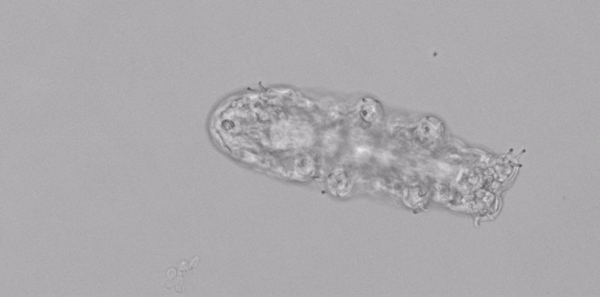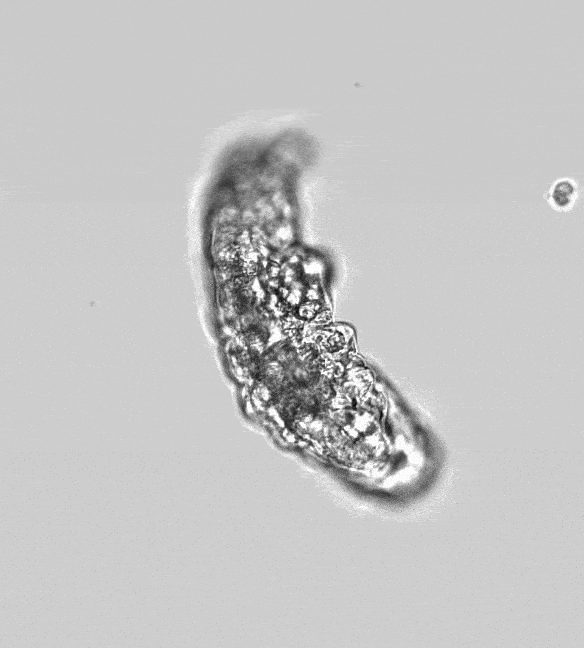As if tardigrades weren’t awesome enough, a new study sheds new light on how (and why) they walk. Using their eight stubby legs to push themselves through sediment and soil, the improbable tardigrades walk like insects 500,00 times their size.

At just 0.05 centimeters (0.02 inch), tardigrades aren’t impressive through size, but they shock in other ways. These water bears, as they’re sometimes called, are so unique that they’ve forced researchers to assign them their own phylum — and a lot of it revolves around their ability to survive almost every known environment.
Tardigrades have been found everywhere on Earth, and I mean everywhere. From the frigid deep sea to mud volcanoes, to the Antarctic and even outer space (where we took them), tardigrades seem capable of surviving everything. They can manage extreme pressure, air deprivation, starvation, radiation, high temperature, low temperature, dehydration, anything that mother nature seems to throw at them, they can handle.
Ever since the 18th century, researchers have looked at tardigrades (though we’ve only recently started to discover some of the things that make them awesome). Some naturalists noted their distinctive, lumbering gates that seem to resemble that of bears. But according to a new study, their gait actually resembles that of insects or arthropods — which raises intriguing questions about their evolution.
Tardigrades are chill
“Tardigrades have a robust and clear way of moving—they’re not these clumsy things stumbling around in the desert or in leaf litter,” says Jasmine Nirody, a fellow in Rockefeller’s Center for Studies in Physics and Biology. “The similarities between their locomotive strategy and that of much larger insects and arthropods opens up several very interesting evolutionary questions.”
Nirody and her colleagues first looked at tardigrades through a microscope. They just sat there and watched tardigrades, for hours and hours.
“If you watch tardigrades under a light microscope for long enough, you can capture a wide range of behavior,” Nirody says. “We didn’t force them to do anything. Sometimes they would be really chill and just want to stroll around the substrate. Other times, they’d see something they like and run towards it.”

They found that tardigrades aren’t exactly fast runners. At a leisurely pace, they would go at about half a body length per second. At full throttle, they’d cover about two body lengths in the same amount of time (the fastest human runners can go at over 4 body lengths per second). But what was interesting was the way they ran.
If you think about a human or a horse, for instance, we have different gaits for different speeds. We walk in one way, we run in another, just like a horse walks in one way, and gallops in another. But tardigrades run like insects, moving their legs in the same fashion they do to walk, only faster.
“When vertebrates switch from walking to running, there is a discontinuity,” Nirody says. “With arthropods, all stepping patterns exist along the same continuum.”
Why even walk?
Most things that are as small as tardigrade don’t walk at all. They just wiggle or crawl around, with walking normally restricted for larger creatures. Because tardigrades move so much like insects, this could hint at a common ancestor. The earliest tardigrades appear to have emerged at some point during the Late Cretaceous, 90 million years ago, but they may have much older origins, diverging from their relatives in the Cambrian some 500 million years ago.

Another possible explanation is that tardigrades aren’t related to insects at all, but reached the same evolutionary strategy simply because it’s most efficient. Since tardigrades spend most of their time on soft substrates and loose sediment, walking could be more advantageous than the other alternatives. This strategy has also been observed on some arthropods as they navigate granular substrates, but it’s unclear if this hints at any evolutionary relationship between the two.
Whichever the case is, it’s equally fascinating, says Nirody.
“If there is some ancestral neural system that controls all of panarthropod walking, we have a lot to learn,” she says. “On the other hand, if arthropods and tardigrades converged upon this strategy independently, then there’s much to be said about what makes this strategy so palatable for species in different environments.”
If this is indeed the most efficient way of navigating the environments which tardigrades inhabit, it could also be important for developing robots for these areas. “Tardigrades are an important porthole into soft-bodied, microscale locomotion,” Nirody adds.
At any rate, there’s still plenty of things we’ve yet to learn about tardigrades, and studying them is bound to return even more findings. After all, learning from creatures that seem able to withstand anything seems like a wise thing to do.


